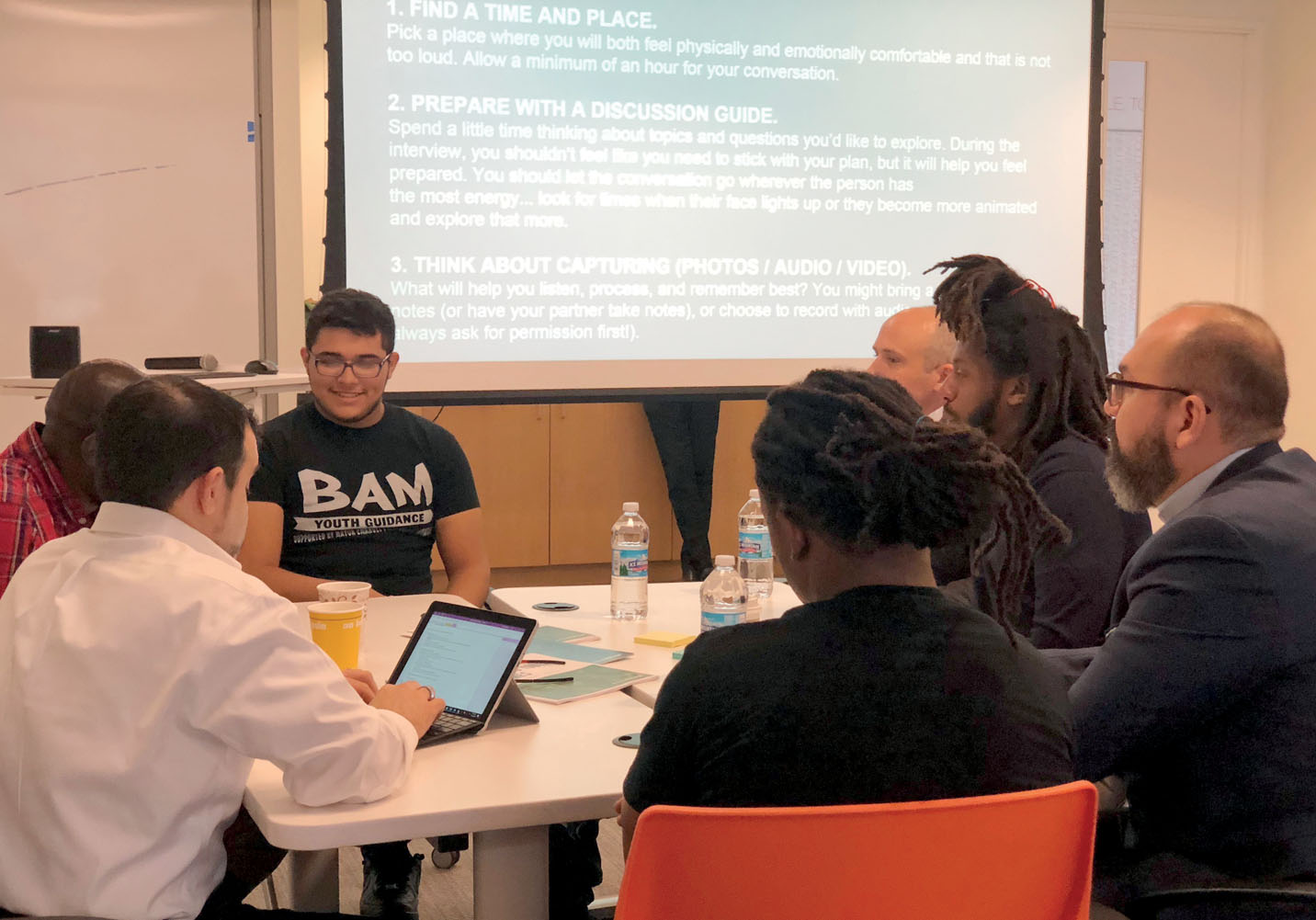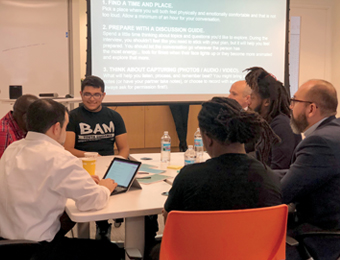Amrita Kulkarni: Tell me about the motivation and mission behind ChiByDesign. Why Chicago?

Chris Rudd: The place I knew best was Chicago; it was home for me. The thinking behind our name was to reflect the fact that Chicago has created us, as well as the message that Chicagoans now need to design the new Chicago.
ChiByDesign came about out of frustration for the design world — majority of designers in the United States are white, but they cannot understand nuanced experiences that black and brown communities face in Chicago today, especially in the social sector. I believe that those closest to the challenges should be the designers of the solutions.
These overwhelmingly white design teams did not resonate with my experience of who I think actually make big changes in the city: activists. These people I knew were typically black and brown, full of creativity. I wanted to create a place for these black and brown designers to come together because we cannot create the new without that type of representation. Since our founding, one of our principles has been that 75% of the team be black and brown, and 50% women — and we’ve stuck with that.
Tell me a bit more about why you chose design as your channel for impact, especially with your prior experience across activism, technology, and policy change.
Design chose me; I didn’t look for it — it found me. Back in 2015 when I was working in Chicago around juvenile justice reform with young people, the Stanford D-School in California found out about my work and invited me to join their Civic Innovation Fellowship. That’s where I learned design; I hadn’t even heard of the field until then. I’ve continued to stay on this path because I think there’s value in the design process, especially in unlocking creativity, something that a lot of us have been trained against doing as adults.
I’m very clear though that so many people problem-solve in very meaningful ways that aren’t considered ‘design’. Given that the birth of design centred very much around industry and corporations, opportunities as well as limitations are created by design as it enters the social space. Right now, many designers simply don’t have the tools to address these complex issues and end up continuing to use the corporate design approach.
Design is newly attempting to focus on social problems with an intent to create solutions, but this has already been done in the activist space as well as other realms for a long time. I think design needs to shed its arrogance. Just because we’ve now made the business case for why design should be taken seriously among Fortune 500 companies does not mean that the design process is the solution to everything.
I wouldn’t even say activism is a discipline, but their processes have figured out how to work with people, listen, be creative, utilise resources and implement. We see programmes that emerged in the pandemic simply because people saw a need, thought creatively about it, and deployed something at scale, even feeding 10,000 people a day! They didn’t need to go to design school to figure that out. Designers need to learn to merge these approaches and practices for more intention and scale.
Those closest to the challenges should be the designers of the solutions
What about the nature of social issues, problems or opportunities? Do these make it a different realm in which to apply a process for change and impact?
The first thing to keep in mind is that when you’re dealing with social issues, you’re really dealing with social relationships. Design currently just thinks about people only in relationship to products and services. Hence the term user, right? You’re only a user when you’re engaging in a particular thing, but the truth is: you are a human for much more and surrounded in a lot more complexity.
Social activists think about that holistic complexity far more than just thinking about a specific experience at, say, the food bank. They understand that there are many dynamics at play in your life that will decide whether or not you can go to the food bank, how you engage with the food bank, and how you get home after. As designers, we’re taught to think of the five Es of experience–Entice, Engage, Enter, Exit and Extend. But that is too one dimensional; there’s far more complexity around social issues and contexts than just one experience or moment.

What has been your design approach and process at ChiByDesign?
We like to say we practice anti-racist design, and this is something I’ve been working on in my academic life at the Institute of Design at IIT, here in Chicago. We realise that typical design frameworks and tools are not sufficient to solve complex social issues, let alone the most complex of them all: racism. And racism is most pervasive; it’s something that touches every social challenge, especially in the United States.
At ChiByDesign we say we have a human centred mindset. We use systems-thinking and trauma-informed design, with a co-design approach. This configuration together creates the opportunity for anti-racism. Over time I’ve developed anti-racist Design Principles, which means that now we have both a guide and an assessment mechanism for our work.
We’ve developed tools for anti-racist insights as a way to understand and make sense of what our research reveals. These afford us the ability to address systems rather than just human experience. And when we create interventions, we think of them as infrastructures rather than just solutions. That means we aim for impact at multiple levels in a system: the micro experience level, mezzo government platform level, and the macro policy level.
We like to think of solutions that really move the trajectory of racism away from the default flow of the system. Unlike in the context of human-centred design, we’re not looking to create a one-to-one micro solution that ultimately bends to the rules of the system, like throwing a stick into a river that moves in accordance with the water. We’re instead looking to create a dam to stop the river from doing what it wants to do, and attempt new things instead.
Racism is most pervasive; it’s something that touches every social challenge, especially in the United States
Can you elaborate on some of the work that you’ve done and its impact?
We’ve done work with City Colleges of Chicago to think about how to better support black and brown community college students from an equity point of view — which is to think about distribution of funds to people across diverse experience levels. How do you create a culture that celebrates successes of these young people, especially in a world that typically downplays what they do? We recommended a concept around activating the city as a support system for the young, including activating new and existing mentorship networks.
We’ve also worked on a project to co-design an equitable food system in Chicago. Working with black and brown urban growers, academics, people at the distribution point, and so on, a new organisation emerged from this work called the Community Food Navigator. This effort is a collaboration with software development company Table XI, and acts as a digital repository for urban growers to learn about each other to connect with one another. Recently, it has evolved into more than just a tech platform; the intent is to bring these groups together so that they can really start to move the needle in terms of the food ecosystem.
We’re also working with the neighbouring state of Ohio to redesign the foster care system to be anti-racist. We’re still in the works with that, but we have secured co-designers on the team that are former foster youth and some are current foster parents. This is how we continue to practice the co-design approach and not be a designer-led organisation. At ChiByDesign, we will always bring the voices and experiences of those nearest to the problem onto the team — to guide, lead and make the work possible.
What’s your dream for Chicago and where do you see its potential?
The place I see the potential for Chicago is really not in the design world; it’s among the young people in the streets. True social change has always happened in the streets, and design can actually contribute a lot to the process. Whether it’s through visual communication and thinking about signs, to digital product design: what are the new tools, UX, or capabilities that social movements need to be able to expand?
The hope I really see is among young people and in their imagination for what can be new. They’re no longer complacent with what is and are now demanding change. That is exciting to me; I think that is where Chicago will grow. Movements are increasingly interracial now; people are just coming together — and not looking at each other based on skin colour. This gives me a lot of hope for Chicago to become the place that I know it can be.



Comments (0)